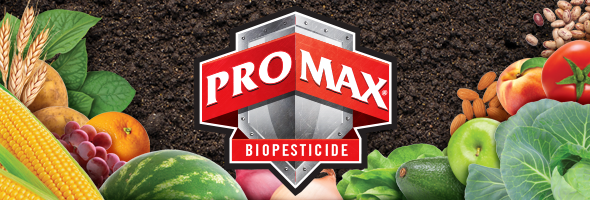
PROMAX® is a soil-applied fungicide and nematicide used as a preventive and curative agent. It is EPA exempt and OMRI listed. It can be applied at any point in the growing season, it doesn’t keep you out of the field, and it is not harmful to roots. It is recommended for the control of many fungal diseases in the soil as well as plant parasitic nematodes in a broad range of crops.
![]()
Is PROMAX® difficult to apply?
Spray and walk. It’s that easy. There is no restricted use. There are no buffer zones, no re-entry intervals, no residue. It’s compatible with most insecticides, miticides, fungicides, herbicides, and fertilizers, and it is considered an ideal product for tank-mix strategies and rotation programs.
![]() What role does PROMAX® play in creating a sustainable soil for future crop production?
What role does PROMAX® play in creating a sustainable soil for future crop production?
With PROMAX®, you’re working toward the long term and not burning out your soil for a quick result. When you implement a program that combines ZAP® 7 to 10 days after your final PROMAX® treatment, you’ve stimulated a beneficial soil biology that will sustain your fields for future crops.
![]()
What’s the cost benefit of using PROMAX®?
Reducing plant-parasitic nematodes and soil-borne diseases results in improved soil health, less plant loss, and higher crop yields. Creating a beneficial soil biology means higher yields for years to come. If you are looking to develop an integrated pest management (IPM) program that is more sustainable, environmentally friendly, and cost effective, PROMAX® is your best choice.
PROMAX® for Tree Nuts & Fruits Articles and Links
Almond Bacterial Canker. These pest management guidelines from the University of California Agriculture & Natural Resources discuss symptoms and signs of bacterial canker as well as ways to manage it and other comments on the disease.
In the Understanding Plants and Soils section of the March issue of The Growing Edge, Rudy Allen, CCAg, CCA-NW, of Ag Tech Services, talks about thymol, the active ingredient of PROMAX®, and how this essential oil offers big advantages over soil-applied pesticides and soil fumigants that are made from synthetic chemicals.
Sampling Procedure to Diagnose Nematode Infestations. The University of Idaho College of Agricultural and Life Sciences provides this protocol and discussion of nematode infestation diagnostics, including a sample Laboratory Check Sheet.
Approach to Nematode Control Changing in Post Methyl Bromide Era. In this 2015 Growing Produce article by Frank Giles, Dr. J.W. Noling is quoted as saying, “In the post-methyl-bromide era, we have to think about opportunities to inflict incremental reductions in nematode populations with each practice. Growers will need to use a variety of chemical and non-chemical tactics. We need to think of nematode control as a year-round, programmatic activity.”
Nematode Management, Chapter 8 in Vegetable Crop Pest Management, from Michigan State University’s Integrated Pest Management resources, provides a general overview on the various types of nematodes and their effects on plant growth. It’s important to know, as noted in this article, that the majority of nematodes present in the soil are considered to be beneficial, and that as the abundance of beneficial nematodes increases, the numbers of plant-parasitic nematodes decrease.
Botanical Nematicides: A Review. Journal of Agricultural and Food Chemistry. This article is highly technical, but it provides a good scientific overview of bionematicides, including thymol—the active ingredient of PROMAX®.
